In the late 1880s, the pieces came together to create a new type of ship that would dominate the seas for most of the next two decades. After 1906, these became known as pre-dreadnoughts. While all of the elements that made them up had been used on previous ships, the end result was to bring an end to the experimental ships and produce the largest fleets of armored capital ships ever seen.
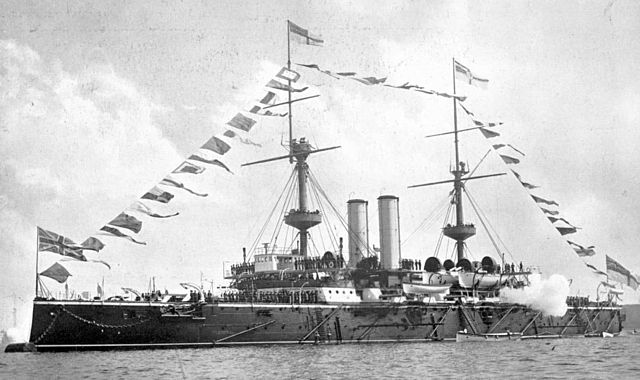
HMS Resolution, of the Royal Sovereign class
As the 1880s drew to a close, Britain faced a serious challenge to her traditional naval dominance. For the previous two decades, the drain of fighting colonial wars had kept the Navy budget low, while other powers had built up their fleets. However, these wars had largely come to an end, and in 1889, the Naval Defence Act was passed, formally establishing that Britain would match the fleets of the next two greatest powers combined, and authorizing 10 battleships over the next four years.1
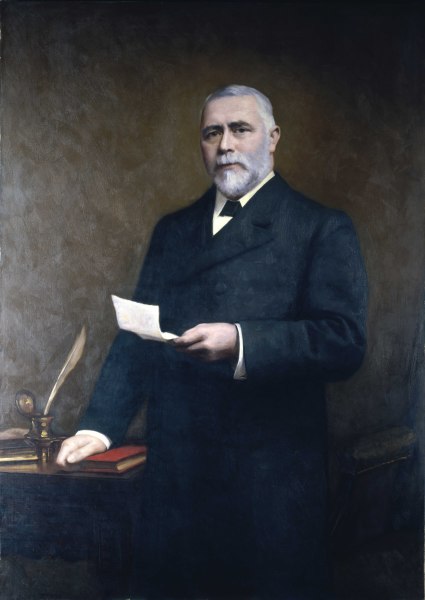
Sir William Henry White
But what sort of ships were to be built under the Act? The First Sea Lord, Admiral Arthur Hood, was a proponent of low-freeboard turret ships, while the Director of Naval Construction, William White, was an advocate of the high-freeboard barbette ship. Eventually, the decision was made mostly in White's favor, as the seven ships of the Royal Sovereign class were high-freeboard ships with open-topped mountings, while one ship, HMS Hood was designed on very similar lines as a low-freeboard turret ship.
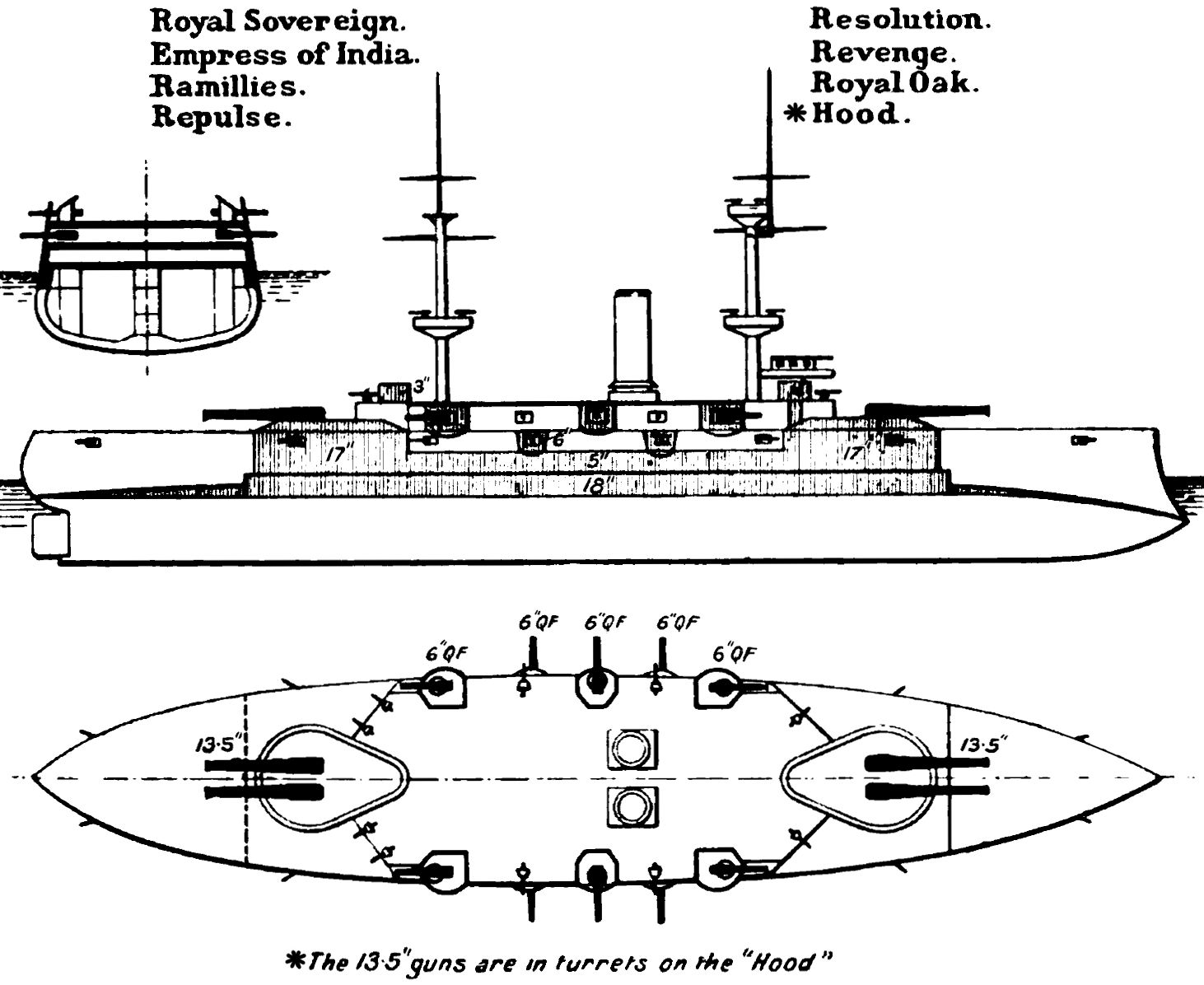
A diagram of the Royal Sovereign class
The Royal Sovereigns were excellent ships. First and foremost, this was because they were significantly bigger than their predecessors, at around 14,000 tons instead of the 10,000 or so that had been the standard since Warrior. A bigger ship makes the designer's job easier, and White could avoid many of the compromises that had plagued older ships. Second, the freeboard was now 18', as opposed to 10' in the proceeding Trafalgars. This made it possible for the Royal Sovereigns to maintain speed and fight their guns effectively in the typical seas found in the Atlantic. The main armament was two pairs of 13.5" guns in open barbette mounts. They carried 10 6" QF guns in casemates on the sides of the ship, the first vessels to be so armed, and five above-water and two submerged 18" torpedo tubes were fitted. For defense against torpedo boats, 16 6pdr and 8 3pdr guns were carried. An 18" lower belt and a 4" upper belt, the first use of pure steel armor on a British ship, provided protection, and their 18 kt speed set a new benchmark for battleships.
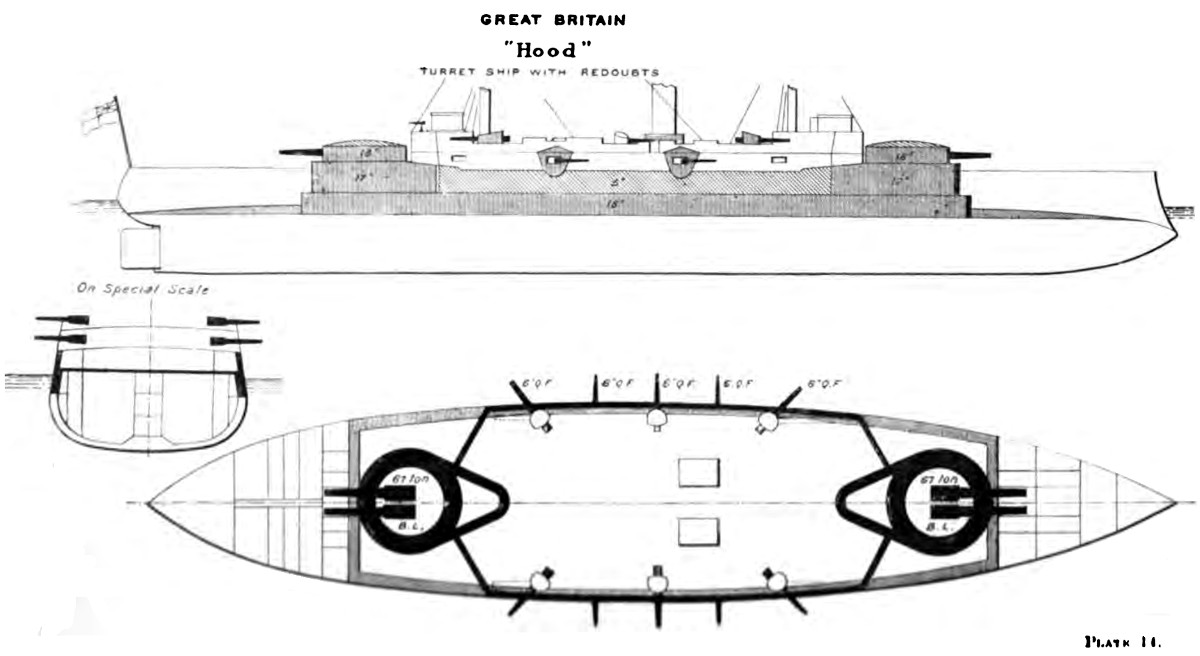
HMS Hood
Hood was a result of a compromise with the faction that still advocated for low-freeboard turret ships.2 She was essentially a Royal Sovereign with the top deck fore and aft cut away, and the top level of the barbette turned into a turret. She was not a particular success, as her 11' freeboard made her very wet.
Besides the advances in size and freeboard, the Royal Sovereigns marked a major organizational shift in the Admiralty. Previously, year-to-year funding of naval construction had stretched out completion of earlier battleships for 7 or more years, while the Naval Defense Act allowed all eight ships to be completed within 5 years of being laid down, a rate of construction that following ships matched or beat. Likewise, they were the first vessels to have a "Board Margin" of several percent of displacement built into the design, to avoid the problems of overweight that plagued the ironclads.

HMS Centurion
The last two Naval Defence Act ships, the Centurions, were second-class battleships intended for service on distant stations, such as China. They were slightly faster than the Royal Sovereigns, and armed with 10" guns. These are usually identified as the first barbette mountings with protection for the crew,3 although I believe it to be more a matter of the British barbette scheme evolving back towards the redoubt/turret arrangement, with the open-backed turrets of the Centurions as an intermediate step. Interestingly, because these ships were not expected to be docked regularly while on foreign stations, they were wood-sheathed underwater and fitted with copper to reduce fouling.
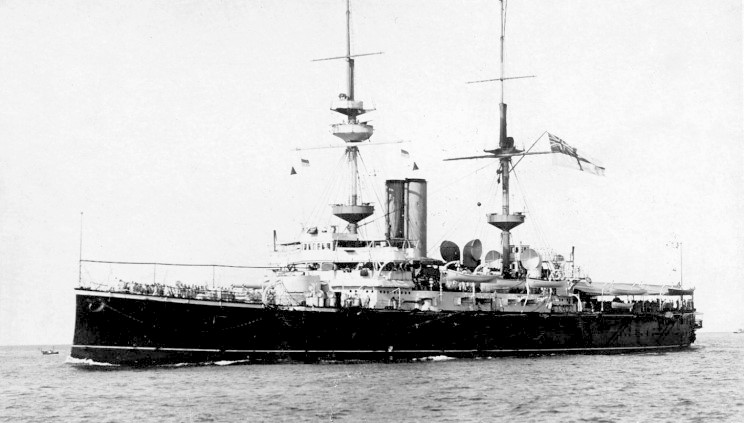
HMS Renown
In 1892, with production of the Royal Sovereigns winding down, it was planned start work on three new battleships. Unfortunately, the planned 12" gun was not ready, and instead a modified version of Centurion was built. She was named Renown, and would later go on to greatly influence Jackie Fisher's thoughts on ships. She was the first British battleship with all-steel armor, and with fully protected high turrets.
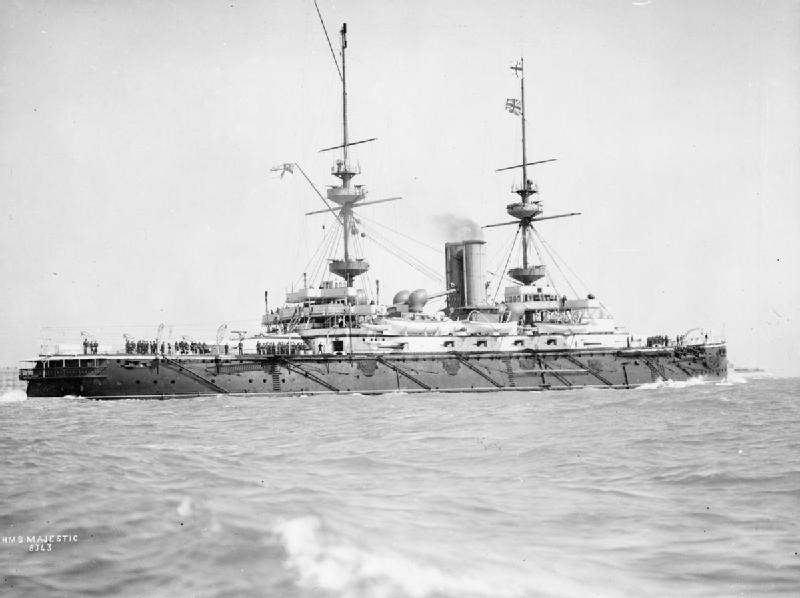
HMS Majestic
By 1893, the issues with the 12" gun had been sorted out and the definitive pre-dreadnought was laid down. HMS Majestic and her eight sisters formed the largest class of battleships ever built. They were superb ships, and set the pattern for the pre-dreadnought both in Britain and abroad. White introduced a new armor scheme,4 where the edges of the deck were sloped down to meet the bottom edges of the belt, instead of the deck lying atop the belt, as on the Royal Sovereigns. This allowed the protection of the deck, 3" on the flat and 4" on the slopes, to be added to the belt, which was reduced to 9", but covered much more of the ship's side than it had on any previous battleship to protect against the recent threat of QF guns.5 Harvey armor was used extensively.
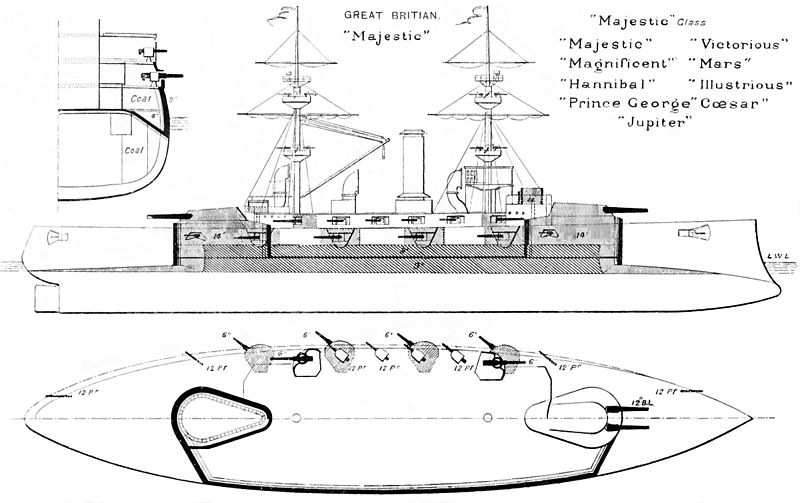
The Majestic Class
Their 12" guns used smokeless cordite to throw projectiles at 720 m/s, as opposed to the 615 m/s muzzle velocity of the 13.5" guns of the Royal Sovereigns. They used turrets similar to those on Renown, which were effective against machine gun and QF fire, if a bit lightly armored relative to foreign designs.6 Later units of the class had improved mountings allowing all-around loading and higher rates of fire. The weight savings from the smaller-caliber main guns allowed an extra pair of 6" QFs, bringing the total aboard to 12, all of them in casemates.
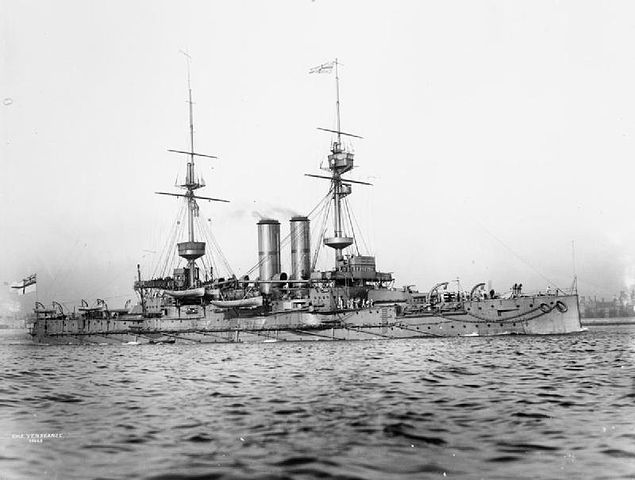
HMS Vengeance, of the Canopus class
The Sino-Japanese War upset British defense planning, and led to the next development in British battleships. The Japanese were investing a great deal of the war indemnity in their fleet, and the British felt the need to produce a class of ships for the Far East to counter them. The resulting Canopus class had a draft limited by the need to transit the Suez Canal and operate on Chinese rivers. They were fitted with Krupp belts only 6" thick, a value not seen since the late 1860s. In many ways, these ships were descendants of Centurion and Renown, although they were the size of first-class battleships and had the same armament.
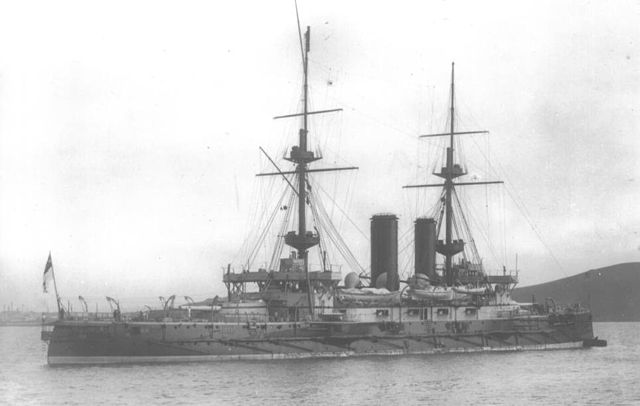
HMS Implacable, of the Formidable class
The next two classes are often described as improved Majestics, although their armor scheme was based on that of Canopus. The Formidable class of 1897 had a 9" Krupp belt, and an improved 12"/40 gun.7 The next year, a few tweaks to the belt armor resulted in the London subclass. In 1898, large additions to the French and Russian building programs lead to an additional four ships being ordered. The Duncan class was designed for 19 kts, one more than had been standard since the Royal Sovereigns. They were slightly smaller than the Formidables and sacrificed a little bit of armor for their speed.
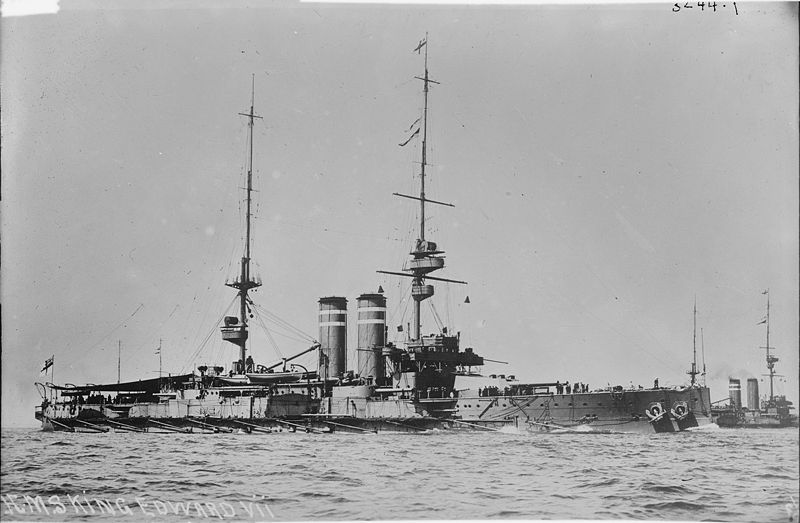
HMS King Edward VII
During this time, foreign ships, most notably the American Virginia class, had begun to sprout guns between the traditional 6" and 12". Improvements in armor had made it possible to provide reasonable protection against the 6" gun, improvements in gun technology had increased the rate of fire of guns of 8-9", and improvements in fire control had increased battle ranges to the point that 6" guns couldn't take advantage of their full rate of fire. The British countered these ships with the first major improvement on the Majestic, in the form of the King Edward VII class of 1901. They were 16,000-ton ships, with 4 12" and 10 6" in the usual places and 4 9.2" guns in turrets on the corners of the superstructure. In practice, this arrangement didn't work particularly well. The ships were crowded, and it proved nearly impossible to control the fire of three separate batteries. Eight units were built, the last last three primarily to ensure continuity of work in the dockyards when the next class was delayed.8
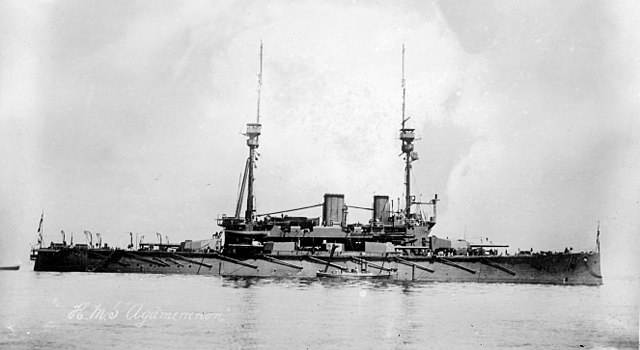
HMS Agamemnon of the Lord Nelson class
The following Lord Nelson class, ordered in 1904, became known as semi-dreadnoughts. These two ships ditched the 6" battery completely, and were armed with 4 12" and 10 9.2" in four twin and two single turrets on the sides of the ship, with 45-caliber guns replacing the 40s of both types.9 The abolition of the 6" battery, and the belts needed to protect it, meant that great improvements in armor protection could be made, the belt returning to 12" with an 8" upper belt. They were ultimately significantly better ships than the King Edwards, and were considered as part of the British battle fleet until just before WWI.
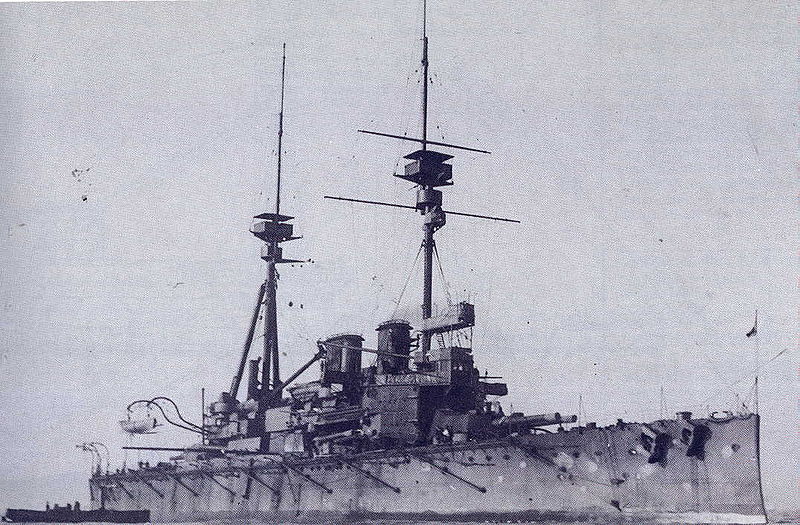
Lord Nelson on trials
Unfortunately, they were completely overshadowed by HMS Dreadnought, who was laid down only 5 months later. One major reason was that their 12" gun mountings were diverted to hurry Dreadnought's completion, and they had to wait for replacement units to be built. Despite being at least partially obsolete on completion, and the fire control problems inherent in mixed main armament, they were good ships, and gave excellent service in the Mediterranean during WWI.
Next time, we'll look at the ship that so influenced the battleship that all other ships of the type are defined by relationship to her. Dreadnought.
1 Interestingly, this appears to be the result of the first ever formal study of the naval strength required to meet British policy objectives. The 10 ships were seven Royal Sovereigns, Hood, and two Centurions. ⇑
2 Admiral Hood the First Sea Lord came from a very distinguished line of naval officers. The ship was named after some of his relatives, not him. ⇑
3 Virtually everyone else was doing it several years earlier, but a lot of warship authors have fairly bad Anglophone myopia. Friedman claims that the shields are the result of a decision to make the guns manually-operated, instead of having automatic controls like in the Royal Sovereigns, which required the crew to expose themselves more to operate the guns. ⇑
4 Actually, the scheme dates to Renown, but I will describe it here. ⇑
5 In total, the weight of vertical armor fell about 10%. ⇑
6 It should be pointed out that the 10" turret faces sloped back about 45°, and probably gave more protection than the barbettes. The sides of the turret were not as heavily armored, and might have been vulnerable if the turret trained away from the target to load. Friedman claims that there was serious thought to using an open barbette, and that the gunhouse was only fitted because of the all-around loading gear introduced in this class, which required the crew to expose themselves above the barbette. ⇑
7 Majestic had a 12"/35. ⇑
8 This was fairly common. Shipyard workers were skilled, and keeping them employed was and is seen as important. ⇑
9 They had originally been planned with six twins, but the need to hold down beam so they could fit into existing docks forced two of the turrets to be replaced with singles. ⇑

Comments
[Bean: The following conversation took place over email, but the other party gave me permission to post it here because I thought it would be of general interest. I've included some notes, because many of my replies in the original were put together rather quickly.]
Reading through the pre-dreadnought article, I was struck by how many ships the British were building. Compare this to modern times where very few ships are being built.
I'd be interested to read about what has changed that makes the pace of construction of ships so different. Is it possible that I'm thinking of the wrong countries and we should be looking at the pace of construction of Chinese ships?
Oh, scratch all that! The US is adding nine ships to the fleet this year. It's strange that the press only focuses on the failures of the Zumwalts and doesn't talk about the fact that there are plenty of good ships coming online...
Ships went from being cheap and mostly costly due to steel to being expensive and mostly costly due to electronics. I just checked, and the British battleships built 1889-1896 cost a total of ~£2 billion in modern terms. Not each year, but across all years.
Is that for all the ships or just for one ship?
I checked the Arleigh Burkes and they’re about $2 billion per ship. Are they bigger than average?
All ships. It was £16.8 million (then year) on battleships during that entire program, covering either 20 or 26 ships, depending on how where the Canopus class falls. So yes, a Burke costs as much as a dozen pre-dreads, give or take.
[I believe the Canopus class was part of that number, but I’m not sure. So the Burke is probably more than a dozen. But at the same time, warship costing is a Lovecraftian mess, and I’m not certain that there isn’t some difference in the accounting method used. I’m not going to take the time to do a full analysis now, but a dozen is at least in the ballpark.]
Could a Burke take out a dozen pre-dreads?
I guess that part of the price inflation could be due to Scott's cost disease? It would be interesting to see how much of it is because of expensive materials and how much of it is due to military contractors padding their pockets. Is that even a problem?
If you ran current Burke vs the pre dreads, I’m not sure exactly what would happen. If the Burke was a little more optimized for surface combat, it would win easily. Cost disease is some of it. More is the increasing complexity of new systems. Contractor padding has probably gone down. I’ve got a post on this coming up in a few weeks.
[The big problem with current Burke v pre-dreads is that the Burke’s weapons are definitely not optimized for that battle. I’d think that the 5″ gun and the SAMs are the sort of threat that pre-dread armor will do well against, leaving only the Harpoons. But the Burke only has 8 of those. I guess the latest Tomahawk blocks have some anti-ship capability, and you might be able to do something with the Mk 46 torpedoes. On the other hand, the pre-dreads will only get in range if the Burke’s crew happens to be asleep. On the gripping hand, that isn’t exactly unknown these days. At the same time, the pre-dreads have no anti-air or anti-submarine capability, which the Burke has a lot of, and the Burke is definitely cheaper to run if we assume that cost per crewmember is constant. We're definitely getting more bang for our buck these days.]
[So yes, a Burke costs as much as a dozen pre-dreads, give or take.]
Is it possible to compare ship unit cost relative to the size of the national economy (GDP) at the time? GDP numbers from the 19th century are less accurate then modern data, that is unavoidable.
I'm sure it's possible. It's not something I have any particular plans to do, but the limits on doing so are going to come primarily from the fact that warship costing is always a bit perilous.